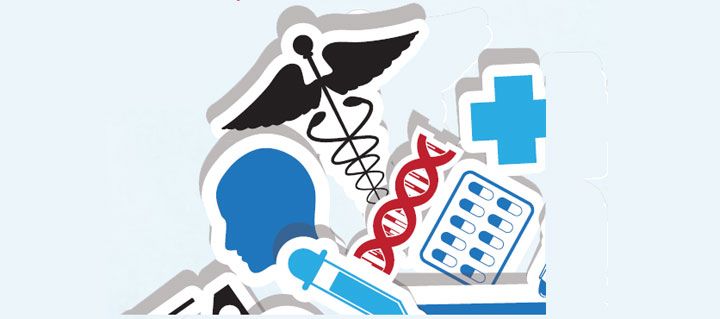Topping the headlines in the U.S. recently has been the nationwide rollout of health insurance exchanges as part of the Patient Protection and Affordable Care Act, otherwise known as the ACA, or Obamacare. For the first time in the country's history, every citizen is required to have health insurance. Previously uninsured individuals, families, and small businesses can purchase insurance as a block via state-run health insurance exchanges (HIXs), designed to eliminate historical barriers such as prohibitive costs or pre-existing condition policies. Thirty-four states opted out of creating their own exchange, so the federal Healthcare.gov exchange was established to connect citizens in those states with participating insurers. Open enrollment began on October 1, 2013, and runs until March 31, 2014. As of February 2014, 3.3 million Americans have enrolled, with a goal of 6 million by the end of March.
It's easy to find news about the website's technical issues, enrollment statistics, and potential repeal votes to the law. But little media coverage has focused on the overall customer experience: what's working, what's not, and what kind of experience are the main players providing consumers as they try to maneuver through this new system? What can agencies, insurers, providers, and other players in the system learn about improving the customer experience going forward?
Why care about customer experience?
Though nothing is as personal as an individual's health, the U.S. healthcare industry has traditionally lacked a consumer focus. Insurance companies worked primarily with company benefit administrators or back-office clerical staff regarding plans, policies, payments, and processing. The consumer, or "member," was a peripheral figure. Now, consumers are taking a more active role in their healthcare, interacting with different players throughout. Insurance carriers must now compete for the best consumers—healthy young adults. States are incentivized to meet certain enrollment numbers, and providers compete for newly insured patients, as well as to retain current patients.
At the same time, consumers expect a consistent experience as they move along the continuum from the exchange through to insurance companies and providers. Their experiences with customer-centric leaders such as Amazon, USAA, and Zappos likely influence their overall expectations for information, accessibility, and service in all industries. Healthcare is no exception.
There's also the data issue. Consumer information is being collected on the exchanges, verified by the IRS and other government agencies, and passed to insurers before relevant plans can even be offered. The consumer just considers one experience, "signing up for health insurance," but on the back-end many disparate systems must integrate and coordinate. All the necessary entities must align around serving the consumer.
So far, that alignment has largely been absent. The customer experience took a back seat to internal issues and political posturing. When Healthcare.gov and the state exchanges went live in October, the experience was downright atrocious. The Guardian newspaper reported that 4.7 million people visited the federal exchange website on its first day, but only six people successfully enrolled. Pages didn't load correctly. Users couldn't input information. In many cases, visitors got a simple message telling them to come back later. A Gallup poll from November 2013 found that 63 percent of Americans reacted negatively to the exchange websites, and only 5 percent of uninsured Americans who logged into any of the exchange sites found the experience to be "very positive." Improvements have been made since, but the overall impression is one of a poor customer experience, even if the user eventually enrolls.
Other HIX interaction channels, such as call centers and walk-in centers, are not much better. Many in-person centers were not physically ready to open by the October 1 launch date, and call centers have been plagued by long wait times, language barriers, and outdated information. In February, California's exchange announced it was hiring 400 more associates to help alleviate its 51-minute average wait time and other issues. And Maryland is investing $6 million to improve operations to its call center, which receives more than 3,000 phone calls per day, according to the Baltimore Sun.
Much has been written about post-enrollment difficulties with insurers. Some have not captured correct member information, been late with sending out membership cards, and delayed instituting coverage. The entire end-to-end customer experience so far is cumbersome, complicated, and frustrating.
Ezekiel Emanuel, a University of Pennsylvania professor and an architect of the ACA for the White House, recently said at a healthcare forum: "The interface isn't perfect and I'm sure by next year when we do this for the 2015 season, you're going to have systems that work better. It won't be the Amazon.com experience but it will be getting close. By 2016, the experience will be the equivalent of Amazon shopping and most people will be happy with it."
That's a tall order, even in a two-year timeframe. There are many customer experience issues that need to be resolved and leveraged before Emanuel's optimistic goal can be realized.
Customer pitfalls of the rollout
Where the customer experience has been uniformly flawed throughout the system "is the lack of communication and lack of managing messages to the citizens around what the expectations should be," says Skip Snow, a Forrester senior analyst.
"There's no one place to get information to tell consumers exactly what they need to know," adds David Oscar, an insurance broker and board member of the New Jersey Association of Health Underwriters (NJAHU). He works as a "navigator" to help consumers and small businesses choose the best health plans. There are many fine-print details to plans listed on the exchanges, and there is little consistency when it comes to plan information, how it's presented, and what gets updated. People get confused about which doctor networks they're in, or the difference between gold, silver, bronze, and platinum plans, for example. "There are so many heads to this monster, and no head talks to each other," Oscar says. "The burden is on consumers to figure it out."
Further muddying the state of customer experience is that lack of coordination, Snow says. Federal officials and contractors will need to provide customers with fluid cross-channel experiences. Until the national exchange is able to pull that off and provide interoperability and ease of navigation across various channels used by consumers, the system will be "outmoded," adds Rick Parrish, senior government customer experience analyst at Forrester.
Another lesson learned from the rollout of the exchanges is that many participants could have done a much better job of managing customer expectations, Snow says. Oscar agrees. "Our expectations were built way beyond the reality," he says. "The problem is that the people in charge already know this, they know what the current experience is actually like, but they don't manage those expectations."
In addition, many of the exchanges (with Healthcare.gov leading the pack) didn't leave sufficient time for end-to-end testing of the entire experience, instead focusing on individual internal pieces of the project.
These challenges are very familiar to anyone who has worked on a customer-based project: lack of coordination and communication, unrealized expectations, and internal focus that supersedes the customer perspective. With the HIX rollout, it just happened very prominently, on a nationwide scale, with future political ramifications.
Customer experience plans that work
It's not all bad. More than 3 million people have successfully enrolled in health insurance plans, according to the Department of Health and Human Services' February 2014 report. The exchange websites received more than 63 million visits and call centers answered nearly 16 million calls through February 1, 2014. The sought-after 18-34 age group represents 25 percent of those enrolled, which bodes well for cost analysis, and some states running their own exchanges have already exceeded enrollment goals.
Connecticut is one of those states, announcing in early February that it had enrolled 121,000 people, having easily surpassed its goal of 120,000 enrollees by March 31, 2014. Part of its success is attributed to the multiple channels through which it interacts with consumers, and the personal assister network available to help consumers through the end-to-end experience.
Kate Gervais is the manager of the Connecticut Navigator and Assister Outreach Program, a division of the state's exchange. Her office oversees more than 300 community groups that assist individuals in their local neighborhoods to get coverage. The assisters walk people through the application process, answering questions about Medicaid eligibility, tax credits, and small business issues, for example. They won't recommend a specific health plan, but they can answer questions and be of general assistance. "The assister owns the relationship," Gervais says. "We stay with the consumer and try to share information when we can."
Gervais' team is part of a multichannel effort to enroll Connecticut residents, which also includes the AccessHealthCT.com website, a 300-associate call center, and two walk-in centers in cities with large uninsured populations. "It's a web, and we're building up that web all the time," Gervais says. To that end, each Tuesday every consumer-facing group meets together to share insights about processes, information, and what they're hearing from consumers, both good and bad. "It's very important that we're on the same page. We talk to consumers every day. We have the opportunity to share that voice with every department. We take that seriously."
Beyond Connecticut, the non-partisan State Health Reform Assistance Network's December study: Report from the States: Early Observations looked at success factors in five other states that operate their own exchanges: Kentucky, New York, Minnesota, Rhode Island, and Washington. They include:
1. Being nimble: States' ability to be nimble has been very important in the early months of marketplace operation, the report reveals.
2. Prioritizing what's critical, and deferring what's not: "Washington State described setting goals and expectations early, taking a disciplined approach to scoping their marketplace and consistently focusing on what had to be done for day one rather than adding a bunch of nice-to-haves," the report states.
3. Cohesive teams with clear lines of authority: The report lauded states that created cross-functional teams of experts with clear missions. "By building cohesive and collaborative teams, states were able to stick to the vision and work plan for marketplace implementation and, most notably, drive timely and effective decision-making."
4. Connections to stakeholders: Internal and external stakeholders are critical to keeping the project focused and moving in the right direction. These states have a "close connection to 'on the ground' stakeholders, including consumers, navigators/consumer assisters, associates/brokers, call centers, and health plans."
Again, these are best practices in any successful customer initiative. The federal program and future state exchanges would be wise to leverage these success factors.
Move forward or get left behind
The exchange experience gets much of the attention in the media, but it's only half the story. The total customer experience involves interactions with insurance companies, as well. These companies have historically scored low on customer experience metrics and satisfaction. The reality of the new healthcare ecosystem means that the old ways of doing business must change. A focus on the individual consumer experience can take a company from regulatory compliance to true competitive differentiation.
Practitioners in the exchanges and payer worlds can benefit from learning more about the interests and profiles of individual customers to personalize messaging, better address their needs, and identify and act on cross-sell and upsell opportunities. For instance, a particular customer may be a good prospect for ambulatory services but doesn't qualify under a plan they're applying for. Working together, the exchanges and insurers can share data and insight to craft a personalized offer for separate ambulatory service, says Omer Minkara, senior research analyst, contact center & customer experience management at Aberdeen Group.
New ways of interacting with customers are beginning to happen. Taking a page from a customer-centric company playbook, Bloomberg recently reported that some consumers complaining about poor experiences to news organizations and on social media were contacted by case workers from the Department of Health and Human Services with a goal to resolve their case within 24 hours. Maybe Emanuel's Amazon-type experience prediction isn't as far off as originally thought.
Just because the March 31 enrollment deadline is approaching doesn't mean that the program is ending. More states are building their own exchanges, new insurance plans and different payers are being added to exchanges, and there is much to do to align all the players for the next enrollment period and enhance the entire system going forward. If the leading players put the customer in the center of the experience, the state of the HIX program and ACA will only get healthier.






